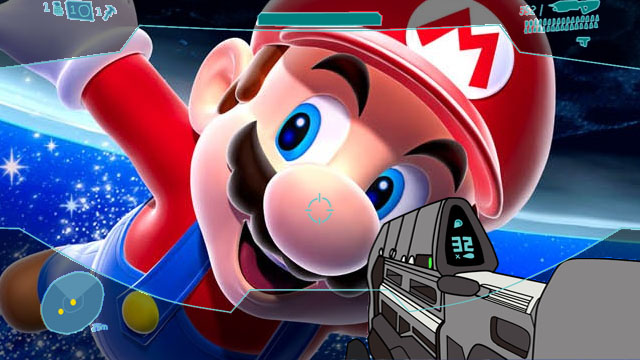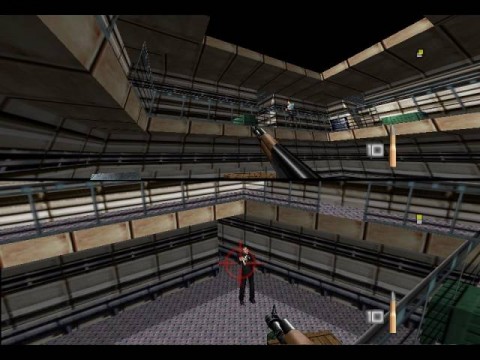 Once upon a time (about 1999, to be exact), Nintendo was the uncontested king of console first-person shooters. Rare’s Goldeneye 007 had brought the entire genre into full prominence (thanks, no doubt, to its addictive and robust multiplayer modes), and it looked as though its spiritual successor Perfect Dark would only continue the publisher’s reign unabated.
Once upon a time (about 1999, to be exact), Nintendo was the uncontested king of console first-person shooters. Rare’s Goldeneye 007 had brought the entire genre into full prominence (thanks, no doubt, to its addictive and robust multiplayer modes), and it looked as though its spiritual successor Perfect Dark would only continue the publisher’s reign unabated.
Somewhere along the way, however, the company’s crown had been forcibly usurped. A new challenger in Microsoft had joined the escalating console wars, looking to extend its dominance into a whole new market. The computer giant’s early success in the game industry hinged primarily on the strength of its premiere launch title, Halo: Combat Evolved, and its platforms have since become the de facto home for every major FPS. Nintendo sought to stem this downturn with its own unique offerings, but its efforts have been largely fruitless– the company’s insistence on innovating within the genre’s conventions has generally proven to be detrimental to its attempts at recapturing this market segment, deterring those who have grown accustomed to (and receptive of) the mechanics found in the most prominent first-person shooters.

Remember this game? So do millions of other once-collegiates and their trashed dorms.
This need to innovate is the crux of its problem. Innovation is not simply a marketing term bandied about by Nintendo’s PR department; it is a core tenet in the company’s design philosophy. The developer’s greatest successes have been found when it dared to venture off the beaten path, a fact no more evident than in the current generation, where its underpowered Wii console broke sales records in the face of its fiercest competition. For one reason or another, however, the company has yet to achieve similar results with first-person shooters. This is not for a lack of trying– despite how ill-equipped Nintendo may seem to compete in this particular category, it has made several strides to rectify its shortcomings. No, the reason Nintendo has not been able to successfully attract this particular audience is because the genre has already matured to the point of saturation. Fans of these titles have grown accustomed to their conventions and mechanics, and any deviation from the norm is typically met by these gamers with indifference or scorn.
Nintendo’s most notable attempt at breaching the FPS market came in Metroid Prime, the first three-dimensional iteration of its esoteric sci-fi franchise. Though the company did well to quash fan backlash by referring to the game as a first-person adventure (a moniker that did prove to be more than mere lip service to the Metroid faithful), it is hard to argue the radical shift in perspective was not, at least in part, the result of Halo’s unexpected success. Nintendo was in dire straits at this particular junction in GameCube’s lifetime, and it needed a hardcore offering that could appeal to fans who may have since become disillusioned with its output. It was certainly no coincidence that Retro’s pedigree consisted of a considerable amount of experience with first-person shooters, and the developer was perhaps its greatest chance of making any sort of headway in this territory. Of course, Nintendo was also not content to simply regurgitate the genre’s conventions within its own properties, and Metroid Prime tempered its gameplay with a liberal dose of innovations.
The title was a rousing success with gaming pundits, but the praise it received in print did not quite translate to the same fervor in sales. Prime‘s unconventional control scheme– a product of its underlying design– and deliberate pacing alienated those who had expected a more typical run-and-gun experience, and all of the accolades in the world could not turn the game into the financial blockbuster it so deserved to be. Nintendo’s attempts at regaining the fickle FPS market, though admirable, were beginning to seem stillborn.

Critically acclaimed, Metroid Prime was no generic FPS. Nor was it, really, an FPS to begin with.
Still, the company took this minor setback in stride and gave it yet another try with Geist, a paranormal GameCube shooter by developer n-Space. The title bore a much closer resemblance to the common FPS than the Metroid Prime series did, but it also bucked the genre’s conventions in its own way by introducing the ability to posses both characters and inanimate objects. As a spectral entity divorced from his body by unorthodox experimentation, the player must explore the insidious compound in which he is being detained in order to regain his corporeal self, jumping from host to host as the situation dictated. Before a character could be possessed, he had to be sufficiently stricken with fear, and the fun of the game became figuring out just how to utilize your environments to frighten these unsuspecting victims.
Despite this intriguing premise, Geist was met with a muted reception. Reviews of the game were largely mixed due to its sluggish controls and impotent engine, and the title’s legacy amounted to being a mere footnote in Nintendo’s history (due to the fact it was the second M-rated game published by the company). Even so, many lackluster titles have been able to achieve commercial success in spite of negative reviews, so why did Nintendo’s innovative shooter ultimately prove to be another failure? The little matter of timing certainly contributed to the issue, but more important was the emergence of online gaming. Wireless multiplayer was quickly becoming a standard feature of the genre, and Geist’s four-player splitscreen mode seemed like an antiquated relic in the age of internet connectivity.

Perhaps not the most well-received FPS ever, though certainly innovative.
Both of the aforementioned examples, strong as they may have been on their own merits, were unable to establish Nintendo as a viable contender in the FPS space. Genre maturation is a deceptively rapid process, especially in recent times as publishers have become increasingly quick to jump on any trends that may seem lucrative. Halo’s success, like Goldeneye 007‘s before it, stemmed not from a compelling campaign (as in Metroid Prime) or an original play mechanic (as in Geist), but from its extensive multiplayer. It single-handedly solidified Microsoft’s position in the console space, and any developer hoping to see even a modicum of that game’s success had no choice but to release its own efforts on the company’s platforms. Because the title cultivated such a devoted audience early on in the console’s lifetime, Microsoft now holds a veritable monopoly on the genre, making it difficult for any competing publisher to wrest this particular market from its grasp.
That said, Nintendo can still develop its own successful first-person shooter, though whether or not it will be able to depends upon equal parts perspiration and happenstance. While its most recent avenue of success has been a far different market than the one discussed in this article, the company has continued to gradually court the FPS audience with quality games (Metroid Prime 3; Goldeneye 007‘s Wii remake) and innovative hardware (Wii Remote), and even its next-generation platform is a self-professed attempt to marry the two disparate consumer groups into a single, inclusive library (a philosophy reflected directly in the console’s name). Regardless, the only way for Nintendo to truly penetrate the FPS market would be to cater to its expectations, a course of action genuinely alien to a company whose greatest strength is its ability to innovate. Its best bet, then, would be to fund an exclusive project with a developer well-versed in the genre and position the resulting title as near to Wii U’s launch as possible. This proposition may seem entirely uncharacteristic of Nintendo, but the company has publicly stated it will be more open to working with other developers to compensate for its own weaknesses. Perhaps this time it won’t just be mere rhetoric.




 ShareThis
ShareThis







“Its best bet, then, would be to fund an exclusive project with a developer well-versed in the genre and position the resulting title as near to Wii U’s launch as possible.”
Is this being accomplished by Killer Freaks from Outer Space?
I was going to mention that game since it is a Wii U launch title, but I ultimately held off on it for two reasons: 1) Nintendo, to my knowledge, isn’t publishing it, so I didn’t think it would fit in with the rest of the article; and 2) for all we know, it could just be another Red Steel (in that it looks like a cool hardcore title, but is too flawed to really make an impact). Either way, information on the game is scarce, and I thought it was too early to mention it until we knew what else was going to show up in Wii U’s launch window. XD